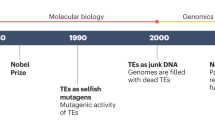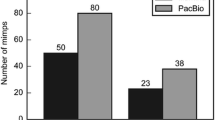Summary
We report here the discovery of a family of transposable elements, which we refer to as Fotl elements, in the fungal plant pathogen Fusarium oxysporum. The first element was identified as an insertion in the gene encoding nitrate reductase. It is 1928 by long, has 44 by inverted terminal repeats, contains a large open reading frame and is flanked by a 2 by (TA) target site duplication. This element shares significant structural similarities with a class of transposons that includes Tc1 from Caenorhabditis elegans and therefore represents a new class of transposable elements in fungi.
Similar content being viewed by others
References
Brezinsky L, Wang GVL, Humphreys T, Hunt J (1990) The transposable element Uhu from Hawaiian Drosophila — member of the widely dispersed class of Tc1-like transposons. Nucleic Acids Res 18:2053–2059
Brierley HL, Potter SS (1985) Distinct characterics of loop sequences of two Drosophila foldback transposable elements. Nucleic Acids Res 13:485–500
Bryan G, Garza D, Hard D (1990) Insertion and excision of the transposable element mariner in Drosophila. Genetics 125:103–114
Burnett JH (1984) Aspects of Fusarium genetics. In: Moss MO, Smith JE (eds) The applied mycology of fusarium. Cambridge University Press, New York, pp 39–69
Cove DJ (1976) Chlorate toxicity in Aspergillus nidulans: the selection and characterisation of chlorate resistant mutants. Heredity 36:191–203
Döring HP, Starlinger P (1986) Molecular genetics of transposable elements in plants. Annu Rev Genet 20:175–200
Eide D, Anderson P (1988) Insertion and excision of the C. elegans transposable element Tc1. Mol Cell Biol 8:737–746
Emmons SW, Yesner L, Ruan K, Katzenberg D (1983) Evidence for a transposon in Caenorhabditis elegans. Cell 32:55–65
Grandbastien MA, Spielmann A, Caboche M (1989) Tntl, a mobile retroviral-like transposable element of tobacco isolated by plant cell genetics. Nature 376–380
Green MM (1988) Mobile DNA elements and spontaneous gene mutation. In: Lambert ME, McDonald JF, Weinstein IB (eds) Eukaryotic transposable elements as mutagenic agents. (Banbury report 30) Cold Spring Harbor Laboratory Press, New York, pp 41–50
Harris LJ, Baillie L, Rose AM (1988) Sequence identity between an inverted repeat family of transposable elements in Drosophila and Caenorhabditis. Nucleic Acids Res 16:5991–5999
Herman RK, Shaw JE (1987) The transposable genetic element Tel in the nematode Caenorhabditis elegans. Trends Genet 3:222–225
Jacobson JW, Medhora MM, Hard DL (1986) Molecular structure of a somatically unstable transposable element in Drosophila. Proc Natl Acad Sci USA 83:8684–8688
Johnstone IL, MacCabe PC, Greaves P, Cole GE, Brow MAD, Gurr S, Unkles SE, Clutterbuck AJ, Kinghorn JR, Innis MA (1990) Isolation and characterisation of the crunA — niiA —niaD gene cluster for nitrate assimilation in Aspergillus nidulans. Gene 90:181–192
Kinsey JA, Helber J (1989) Isolation of a transposable element from Neurospora crassa. Proc Natl Acad Sci USA 86:1929–1933
Lillis M, Freeling M (1986) Mu transposition in maize. Trends Genet 183–188
McHale MT, Roberts IA, Talbot NJ, Oliver RP (1989) Expression of reverse transcriptase genes in Fulvia fulva. Mol Plant Microb Interact 2:165–168
Malardier L, Daboussi MJ, Julien J, Roussel F, Scazzocchio C, Brygoo Y (1989) Cloning of the nitrate reductase gene (niaD) of Aspergillus nidulans and its use for transformation of Fusarium oxysporum. Gene 78:147–156
Rosenzweig B, Lioa LW, Hirsh D (1983) Sequence of the C. elegans transposable element Tc1. Nucleic Acids Res 11:4201–4209
Valent B, Chumley FG (1991) Molecular genetic analysis of the rice blast fungus, Magnaporthe grisea. Annu Rev Phytopathol, in press
Whitehead MP, Gurr JJ, Grieve C, Unkles SE, Spence D, Ramsden M, Kinghorn JR (1990) Homologous transformation of Cephalosporium acremonium with the nitrate reductase-encoding gene (niaD) Gene 90:193–198
Author information
Authors and Affiliations
Rights and permissions
About this article
Cite this article
Daboussi, MJ., Langin, T. & Brygoo, Y. Fot1, a new family of fungal transposable elements. Molec. Gen. Genet. 232, 12–16 (1992). https://doi.org/10.1007/BF00299131
Received:
Issue Date:
DOI: https://doi.org/10.1007/BF00299131




